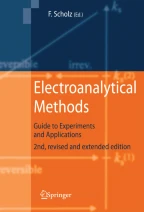
In most electrochemical measurements, it is necessary to keep one of the electrodes in an electrochemical cell at a constant potential. This so-called reference electrode allows control of the potential of a working electrode (e.g. in voltammetry) or the measurement of an indicator electrode (e.g. in potentiometry, see Chap. II.9). The standard hydrogen electrode plays the role of a basic reference element in electrochemical devices; however, in practice, it is difficult to handle. Therefore, secondary reference electrodes are preferred in most experiments. A secondary reference electrode must fulfil the following criteria: (i) it should be chemically and electrochemically reversible, i.e. its potential is governed by the Nernst equation and does not change in time; (ii) the potential must remain almost constant when a small current passes through the electrode and reverse to its original value after such small current flow (i.e. a non-polarisable electrode); and (iii) the thermal coefficient of potential should be small.
This is a preview of subscription content, log in via an institution to check access.
eBook EUR 93.08 Price includes VAT (France)
Softcover Book EUR 116.04 Price includes VAT (France)
Hardcover Book EUR 158.24 Price includes VAT (France)
Tax calculation will be finalised at checkout
Purchases are for personal use only